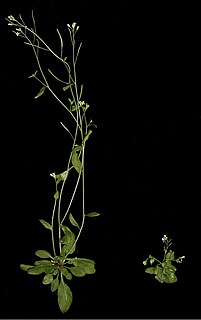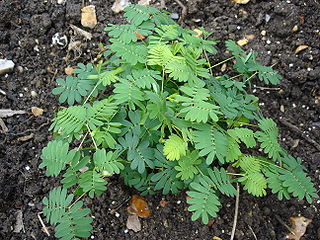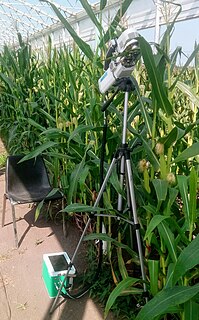Abiotic stress is the negative impact of non-living factors on the living organisms in a specific environment. The non-living variable must influence the environment beyond its normal range of variation to adversely affect the population performance or individual physiology of the organism in a significant way.

Plant hormone are signal molecules, produced within plants, that occur in extremely low concentrations. Plant hormones control all aspects of plant growth and development, from embryogenesis, the regulation of organ size, pathogen defense, stress tolerance and through to reproductive development. Unlike in animals each plant cell is capable of producing hormones. Went and Thimann coined the term "phytohormone" and used it in the title of their 1937 book.

The mung bean, alternatively known as the green gram, maash ٫ mūng, monggo, or munggo (Philippines), is a plant species in the legume family. The mung bean is mainly cultivated in East, Southeast and South Asia. It is used as an ingredient in both savoury and sweet dishes.
Thermotropism or thermotropic movement is the movement of an organism or a part of an organism in response to heat or changes from the environment's temperature. A common example is the curling of Rhododendron leaves in response to cold temperatures. Mimosa pudica also show thermotropism by the collapsing of leaf petioles leading to the folding of leaflets, when temperature drops.
Moisture stress is a form of abiotic stress that occurs when the moisture of plant tissues is reduced to suboptimal levels. Water stress occurs in response to atmospheric and soil water availability when the transpiration rate exceeds the rate of water uptake by the roots and cells lose turgor pressure. Moisture stress is described by two main metrics, water potential and water content.
Ecophysiology, environmental physiology or physiological ecology is a biological discipline that studies the response of an organism's physiology to environmental conditions. It is closely related to comparative physiology and evolutionary physiology. Ernst Haeckel's coinage bionomy is sometimes employed as a synonym.

Plant perception is the ability of plants to sense and respond to the environment by adjusting their morphology and physiology. Botanical research has revealed that plants are capable of reacting to a broad range of stimuli, including chemicals, gravity, light, moisture, infections, temperature, oxygen and carbon dioxide concentrations, parasite infestation, disease, physical disruption, sound, and touch. The scientific study of plant perception is informed by numerous disciplines, such as plant physiology, ecology, and molecular biology.
Drought tolerance is the ability to which a plant maintains its biomass production during arid or drought conditions. Some plants are naturally adapted to dry conditions, surviving with protection mechanisms such as desiccation tolerance, detoxification, or repair of xylem embolism. Other plants, specifically crops like corn, wheat, and rice, have become increasingly tolerant to drought with new varieties created via genetic engineering.
Specific leaf area (SLA) is the ratio of leaf area to leaf dry mass. The inverse of SLA is Leaf Mass per Area (LMA).
Biotic stress is stress that occurs as a result of damage done to an organism by other living organisms, such as bacteria, viruses, fungi, parasites, beneficial and harmful insects, weeds, and cultivated or native plants. It is different from abiotic stress, which is the negative impact of non-living factors on the organisms such as temperature, sunlight, wind, salinity, flooding and drought. The types of biotic stresses imposed on an organism depend the climate where it lives as well as the species' ability to resist particular stresses. Biotic stress remains a broadly defined term and those who study it face many challenges, such as the greater difficulty in controlling biotic stresses in an experimental context compared to abiotic stress.
Joy K. Ward is a leading evolutionary biologist studying the impact of the environment on plants and ecosystems. She began a new role as the dean of the College of Arts & Sciences at Case Western Reserve University on July 1, 2020 - leaving behind her professorship at the University of Kansas. Her research on plant life has gained her notoriety in many scientific research fields. Aside from her work in the lab, she is also a strong advocate for advancing underrepresented communities' scientific learning and careers. As part of her deanship at the University of Kansas, Ward was an important factor in increasing the number of underrepresented individuals who held faculty positions in STEM subjects. Notably, as a result of her research efforts, she was awarded the Presidential Early Career Award for Scientists and Engineers by U.S. President Barack Obama.

Drought deciduous, or drought semi-deciduous plants refers to plants that shed their leaves during periods of drought or in the dry season. This phenomenon is a natural process of plants and is caused due to the limitation of water around the environment where the plant is situated. In the spectrum of botany, deciduous is defined as a certain plant species that carry out abscission, the shedding of leaves of a plant or tree either due to age or other factors that causes the plant to regard these leaves as useless or not worth keeping over the course of a year. Deciduous plants can also be categorised differently than their adaptation to drought or dry seasons, which can be temperate deciduous during cold seasons, and in contrast to evergreen plants which do not shed leaves annually, possessing green leaves throughout the year.

Photosynthesis systems are electronic scientific instruments designed for non-destructive measurement of photosynthetic rates in the field. Photosynthesis systems are commonly used in agronomic and environmental research, as well as studies of the global carbon cycle.
Breeding for drought resistance is the process of breeding plants with the goal of reducing the impact of dehydration on plant growth.
Julia Bailey-Serres is professor of genetics, director of the Center for Plant Cell Biology, and a member of the Institute for Integrative Genome Biology at the University of California, Riverside. Her accomplishments include the pioneering of methods for profiling the "translatomes" of discrete cell-types of plants and identification of a homeostatic sensor of oxygen deprivation in plants.
Marilyn Ball is a professor at the College of Medicine, Biology and Environment at the Australian National University (ANU), and leader of the Ball (Marilyn) Lab for Ecophysiology of Salinity and Freezing Tolerance.
Christine Helen Foyer is professor of plant science at the University of Birmingham, Birmingham, UK. She is President Elect of the Association of Applied Biologists, the General Secretary of the Federation of European Societies of Plant Biologists, an elected Board Member of the American Society of Plant Biologists and a Member of the French Academy of Agriculture. She has published and co-authored many papers on related subjects.
Paramjit Khurana is an Indian scientist in Plant Biotechnology, Molecular Biology, Genomics who is presently Professor in the Department of Plant Molecular Biology in the University of Delhi, Delhi. She has received many awards and published more than 125 scientific papers.

Charlotte Elliott (1883-1974) was a pioneering American plant physiologist specializing in bacterial organisms that cause disease in crops who was the author of a much-used reference work, the Manual of Bacterial Plant Pathogens. She was the first woman to receive a Ph.D. in botany from the University of Wisconsin, Madison.
Jian-Kang Zhu is a plant scientist, researcher and academic. He is a Senior Principal Investigator in the Shanghai Center for Plant Stress Biology, Chinese Academy of Sciences (CAS). He is also the Academic Director of CAS Center of Excellence in Plant Sciences.






